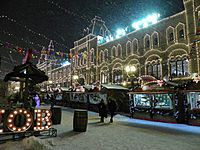Christmas in Russia facts for kids
Quick facts for kids Christmas in Russia |
|
|---|---|

A Christmas market in Red Square, 2017
|
|
| Official name | Рождество Христово (Rozhdestvo Khristovo) |
| Observed by | Christians, many non-Christians |
| Significance | Commemoration of the Nativity of Jesus |
| Celebrations | Christmas tree decorations, gift-giving, family and other social gatherings, feasting, etc. |
| Observances | Church services |
| Date |
|
| Frequency | annual |
| Related to | Nativity Fast |
Christmas in Russia is a special holiday that celebrates the birth of Jesus Christ. In Russian, it's called Рождество Христово (Rozhdestvo Khristovo). The Russian Orthodox Church calls it Е́же по пло́ти Рождество Господа Бога и Спа́са нашего Иисуса Христа.
Most people in Western countries celebrate Christmas on December 25th. However, in Russia, Christmas is celebrated on January 7th. This is because the Russian Orthodox Church uses the older Julian calendar. January 7th on our modern calendar is the same as December 25th on the Julian calendar.
Christmas is a very important holiday for the church. It is one of the 12 Great Feasts. Before Christmas, many people observe a period of fasting. Traditional Russian Christmas celebrations begin on Christmas Eve, which falls on January 6th.
For much of the 1900s, Christmas was not widely celebrated in Russia. This was due to the Soviet Union's rules against religion. But many Christmas traditions lived on, often moving to New Year's Day. After the Soviet Union ended in the 1990s, Christmas became a holiday again. Still, New Year's Day remains the biggest holiday in Russia.
Contents
History of Russian Christmas
Christmas became an official holiday in Russia after Prince Vladimir ordered the baptism of Rus' in the late 900s. However, Christians might have celebrated it even earlier in Kievan Rus'.
Christmas Traditions Begin
In the 1800s, the Christmas tree became a big part of the holiday. This tradition came from Prussia with Nicholas I's wife, Alexandra Feodorovna. She was from Prussia and brought the idea to Russia.
Giving gifts to children at Christmas also started around this time. Children usually received candy, books, toys, and clothes. These gifts were traditionally brought by Ded Moroz (Grandfather Frost). He is like Saint Nicholas or Father Christmas, but usually taller.
Ded Moroz comes from old Slavic stories. He travels with his beautiful granddaughter, Snegurochka (The Snow Maiden). They ride in a sleigh pulled by three horses.
Christmas During Soviet Times
In the early Soviet period, the government did not encourage religious celebrations. They believed in atheism, which means not believing in God. The Bolsheviks said Christmas was an old pagan ritual and that the Christmas tree was a foreign idea.
In 1929, all religious holidays, including Christmas, were stopped by the government. But in 1935, things changed. Many Russian Christmas traditions were brought back, but for a secular New Year's celebration.
The Christmas tree became the "New Year's fir tree." Children all over the Soviet Union enjoyed it. Other Christmas traditions, like gift-giving and visits from Ded Moroz, became part of New Year's celebrations. They lost their religious meaning and became secular.
In 1991, after the Soviet Union broke apart, Christmas was brought back as a religious holiday.
Christmas Church Services
On Christmas Eve, which is January 6th, there are long church services. These include the Royal Hours and Vespers combined with the Divine Liturgy. This service marks the end of the long Nativity Fast.
After church, families go home for the traditional Christmas Eve dinner. This meal is called the Holy Supper. It has 12 dishes, one for each of the Twelve Apostles. The meal does not include meat because it is a fasting day.
Many religious families return to church for the All Night Vigil and the Midnight Divine Liturgy. If people cannot go to church, they can watch the service on TV. The main service is broadcast from the Cathedral of Christ the Saviour in Moscow.
On Christmas Morning, families go back to church for the Morning Divine Liturgy of the Nativity. Since 1992, Christmas has been a national holiday in Russia. It is part of the ten-day holidays at the start of the new year.
Traditional Christmas Food
Christmas dinner in old Russia had many delicious dishes. Some main dishes included roasted pig, stuffed pig's head, and roasted meat chunks. There was also jelly (kholodets) and aspic.
The Christmas table often had many other meats. These included goose with apples, sour cream hare, venison, and lamb. Whole fish was also common. The large Russian oven helped prepare these big meals.
Thinly sliced meat and pork were cooked in pots with traditional porridge. Pies were also very important for Christmas and other holidays. There were many kinds of pies, both closed and open. These included pirogi, pirozhki, vatrushkas, coulibiacs, and kalachi. They had fillings of all kinds: herbs, vegetables, fruits, mushrooms, meat, fish, and cheese.
Sweet dishes on the Russian Christmas table included berries, fruit, candy, and cakes. There were also angel wings (a type of pastry), biscuits, and honey. For drinks, people had broths like kompot and sweet soups. They also drank sbiten and, starting in the 1700s, Chinese tea.
See also
- Koliada
- Christmas worldwide
- Novy God
- Orthodox New Year
- Religion in Russia

